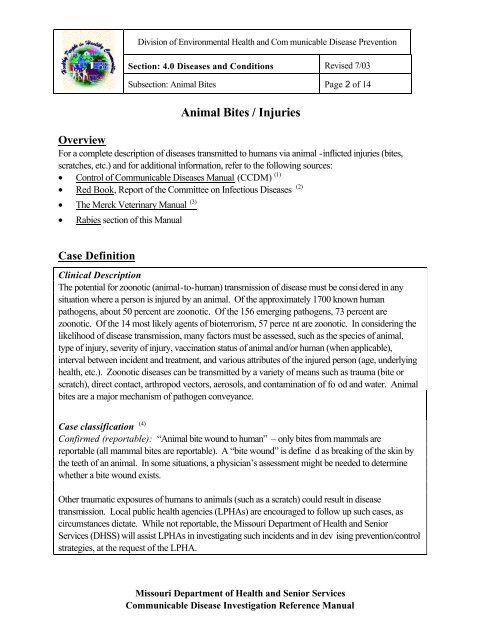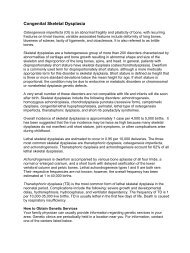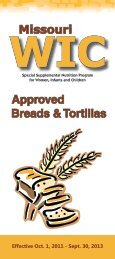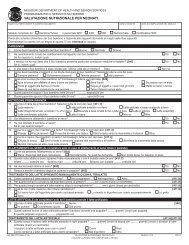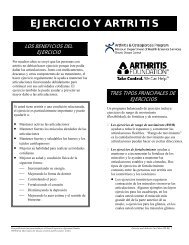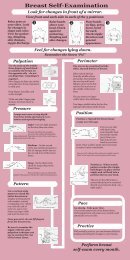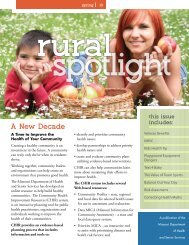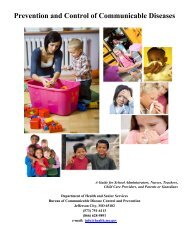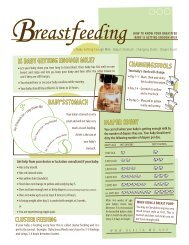Animal Bites / Injuries - Missouri Department of Health & Senior ...
Animal Bites / Injuries - Missouri Department of Health & Senior ...
Animal Bites / Injuries - Missouri Department of Health & Senior ...
You also want an ePaper? Increase the reach of your titles
YUMPU automatically turns print PDFs into web optimized ePapers that Google loves.
Division <strong>of</strong> Environmental <strong>Health</strong> and Com municable Disease Prevention<br />
Section: 4.0 Diseases and Conditions Revised 7/03<br />
Subsection: <strong>Animal</strong> <strong>Bites</strong> Page 2 <strong>of</strong> 14<br />
<strong>Animal</strong> <strong>Bites</strong> / <strong>Injuries</strong><br />
Overview<br />
For a complete description <strong>of</strong> diseases transmitted to humans via animal -inflicted injuries (bites,<br />
scratches, etc.) and for additional information, refer to the following sources:<br />
• Control <strong>of</strong> Communicable Diseases Manual (CCDM) (1)<br />
• Red Book, Report <strong>of</strong> the Committee on Infectious Diseases (2)<br />
• The Merck Veterinary Manual (3)<br />
• Rabies section <strong>of</strong> this Manual<br />
Case Definition<br />
Clinical Description<br />
The potential for zoonotic (animal-to-human) transmission <strong>of</strong> disease must be consi dered in any<br />
situation where a person is injured by an animal. Of the approximately 1700 known human<br />
pathogens, about 50 percent are zoonotic. Of the 156 emerging pathogens, 73 percent are<br />
zoonotic. Of the 14 most likely agents <strong>of</strong> bioterrorism, 57 perce nt are zoonotic. In considering the<br />
likelihood <strong>of</strong> disease transmission, many factors must be assessed, such as the species <strong>of</strong> animal,<br />
type <strong>of</strong> injury, severity <strong>of</strong> injury, vaccination status <strong>of</strong> animal and/or human (when applicable),<br />
interval between incident and treatment, and various attributes <strong>of</strong> the injured person (age, underlying<br />
health, etc.). Zoonotic diseases can be transmitted by a variety <strong>of</strong> means such as trauma (bite or<br />
scratch), direct contact, arthropod vectors, aerosols, and contamination <strong>of</strong> fo od and water. <strong>Animal</strong><br />
bites are a major mechanism <strong>of</strong> pathogen conveyance.<br />
Case classification (4)<br />
Confirmed (reportable): “<strong>Animal</strong> bite wound to human” – only bites from mammals are<br />
reportable (all mammal bites are reportable). A “bite wound” is define d as breaking <strong>of</strong> the skin by<br />
the teeth <strong>of</strong> an animal. In some situations, a physician’s assessment might be needed to determine<br />
whether a bite wound exists.<br />
Other traumatic exposures <strong>of</strong> humans to animals (such as a scratch) could result in disease<br />
transmission. Local public health agencies (LPHAs) are encouraged to follow up such cases, as<br />
circumstances dictate. While not reportable, the <strong>Missouri</strong> <strong>Department</strong> <strong>of</strong> <strong>Health</strong> and <strong>Senior</strong><br />
Services (DHSS) will assist LPHAs in investigating such incidents and in dev ising prevention/control<br />
strategies, at the request <strong>of</strong> the LPHA.<br />
<strong>Missouri</strong> <strong>Department</strong> <strong>of</strong> <strong>Health</strong> and <strong>Senior</strong> Services<br />
Communicable Disease Investigation Reference Manual


